Universal's Halloween Horror Nights redefines the haunt with a Weeknd-inspired maze
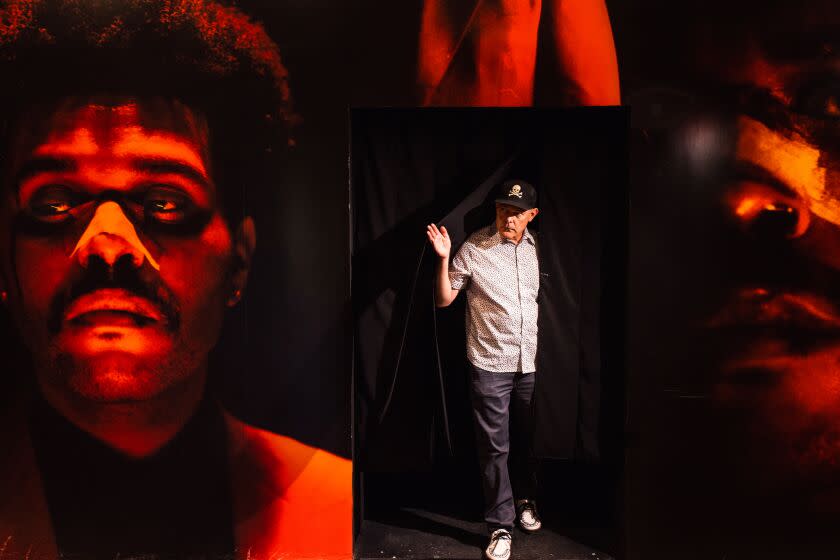
- Oops!Something went wrong.Please try again later.
Romance, in the songs and videos of the Weeknd, is often a horror show — a desolate wasteland where sex, drugs and love are life-wrecking obsessions. The protagonist is regularly an addict, yearning for emotions as much as substances, and letting himself down as often as any of his partners. For as sleek as the music can be, the lyrics are claustrophobic, a peek into someone tortured equally by delusions and uncontrollable compulsions.
The demons in a Weeknd song are in our mind. A song such as "After Hours" may get a crowd dancing, but it also mixes together regret, reconciliation, promises, lies and a fear of loneliness as a torturous, don't-fall-for-it-again cocktail.
So when the artist born Abel Tesfaye expressed interest in having his music score a haunted house at Universal Studios' annual Halloween Horror Nights event, the creative principal behind the festivities had just one thought after listening to the 2020 album "After Hours," upon which the maze is based: "My opening line of the pitch — the way I saw this whole thing — was, 'If we could be inside your head when you were creating this album, what would that feel like, look like and would we survive that experience?'" says John Murdy.
The resulting theater has the requisite jump scares and macabre imagery. The squeamish should be warned that there's no shortage of beheadings and revolting twists on cosmetic surgeries — but Murdy and his Universal team aimed to turn recognizable imagery, such as nightclubs and subway stations, into a metaphorical nightmare that reflects our most superficial tendencies. It's a slight pivot for Universal Horror Nights' typical fear-filled fare. Consider the maze an attempt to create panic and fights out of more existential themes, a trend that began earnestly in 2019 with a walk-through attraction themed to Jordan Peele's "Us."
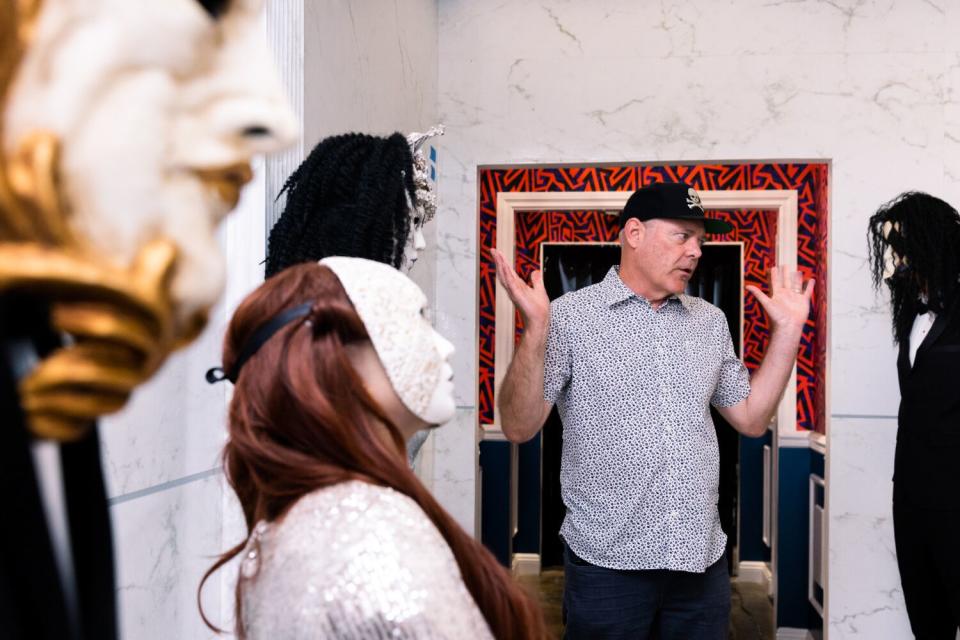
Murdy, a horror lifer, sees the shift as a generational one, representative of an era in which our biggest fears are more internal. Horror as a genre, says Murdy, "taps into whatever people are afraid of at that moment."
Universal Studios Hollywood's Weeknd-inspired maze launches Thursday with Halloween Horror Nights, which runs through Halloween, and is one of eight haunted houses as part of this year's event. It stands in contrast to mazes themed to franchises such as "Halloween," "Killer Klowns From Outer Space" and the horror films of Blumhouse Productions, and while music has been a big part of Halloween Horror Nights in the past, the artists associated with it are typically those more aligned with traditional horror imagery such as Alice Cooper and Rob Zombie.
"If you just hear 'Blinding Lights' on the radio," Murdy says of the Weeknd's hit, "you really wouldn't necessarily associate that with horror. So this was about diving into the persona of the man who created it."
But those familiar with the Weeknd's imagery, specifically his music videos, will likely see a horror influence start to creep into the artist's music. Even his 2021 Super Bowl performance had some borderline-demented, theme-park-like moments, such as the artist running through a garish hall of mirrors with bandaged dancers. That moment gets a nod in Universal's maze in a scene that will seek to disorient guests with two-way mirrors, tricks of the light and a mix of actors and static figures providing a bounty of misdirection.
"You know someone is going to jump out at you," Murdy says. "You just don't know where."
Murdy has overseen Hollywood's Halloween Horror Nights event since 2006, when he resurrected an event that had previously been sporadic. But his horror obsession is significantly deeper. Since about the age of 10, Murdy says, he was turning his family's Hacienda Heights home into haunted houses. The hobby lasted about four years.
"It got a little ridiculous," Murdy says. "I started taking over vast sections of my parents' house, and telling my dad, 'You can't park in the garage.' One Halloween, when I was 14, my dad looked out the window and saw 200 people lined up trampling his rose garden. I was playing Norman Bates popping out of the shower with a real knife I took from the kitchen, and my dad's face went white. He said, 'You can't do this anymore. We're going to be sued.' I was running around with a knife. My friend was running around with a real axe. It was the '70s."
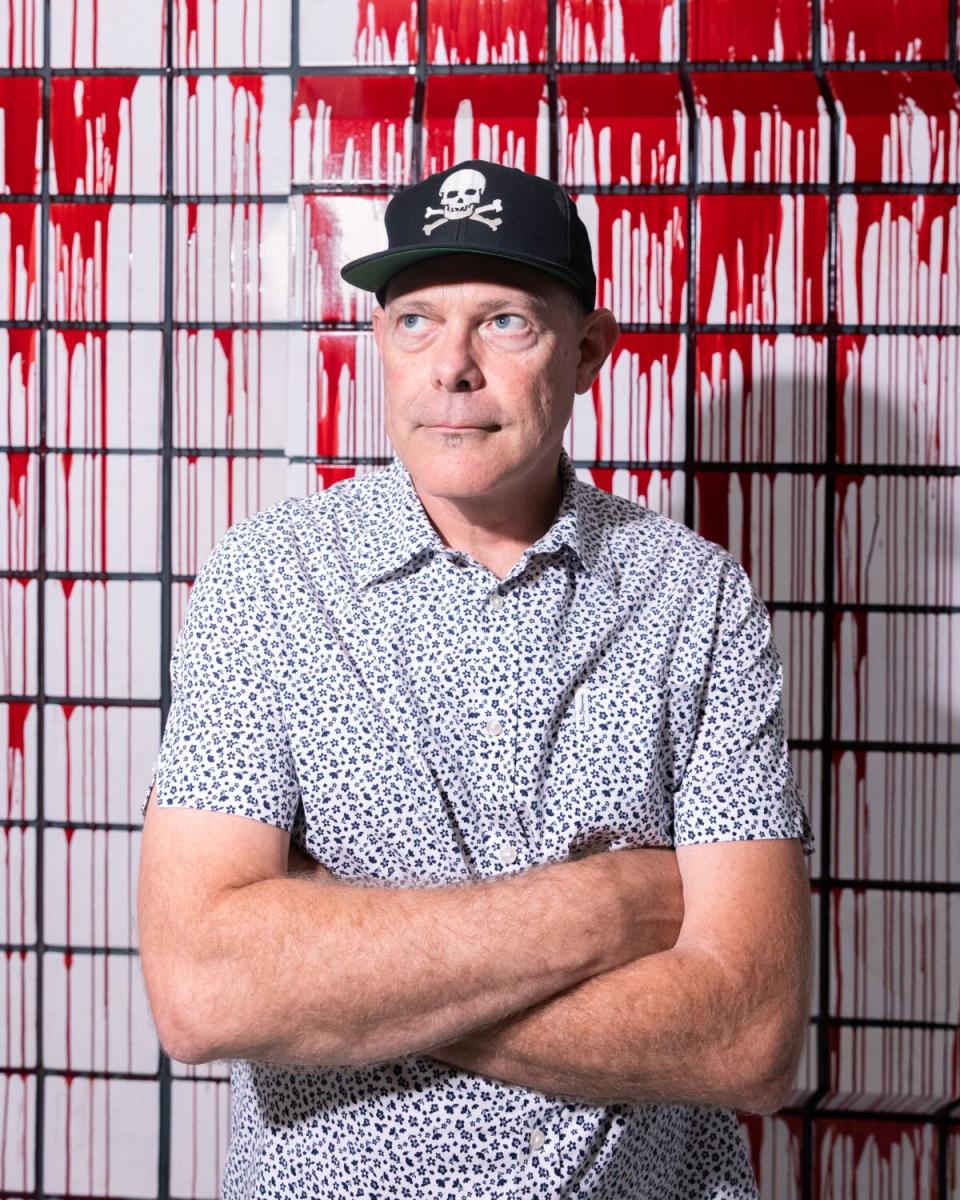
There's no real danger at a Halloween Horror Nights maze, and Murdy says the team this year is putting an even larger emphasis on telling cohesive stories. For instance, he hopes that, in a maze themed to a 1920s hotel, guests will stop and watch a newsreel that sets up the plot of what they're about to see. "It's a test to see if people will pay attention," Murdy says. "It's a chaotic, noisy event, and that's a little test we're doing to see if it works, and if it's another way to do storytelling for us."
But nowhere is there more of a narrative than in the Weeknd haunt, which has the full name of "The Weeknd: After Hours Nightmare." Luckily, Tesfaye's collection of music videos for "After Hours," and an accompanying short film, provided plenty of grisly fodder.
Murdy tried to honor the influences of those clips, which include multiple Stanley Kubrick films as well as works such as "Fear and Loathing in Las Vegas," among others. The opening scene of the maze could be a spacey take on "A Clockwork Orange," with a Weeknd figurine hooked up to something of a nightmare machine, in which an all-white room outfitted with video monitors is made to look as if it is pulling images from the figure's mind.
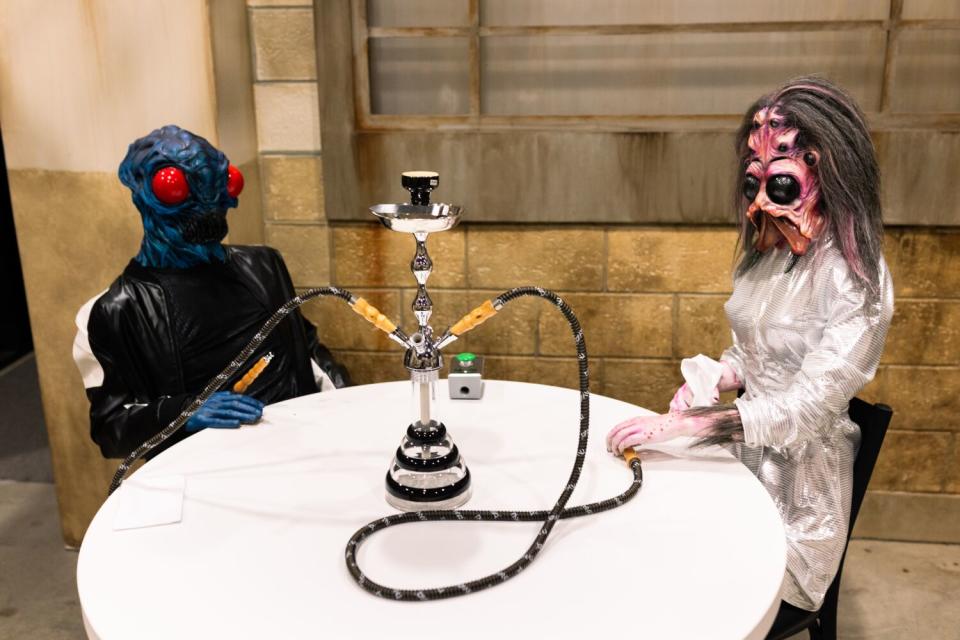
Things only get more trippy from there, as guests are led into a nightclub in a warehouse full of hookah-inhaling aliens. Little details guests may miss are peppered throughout, such as plates filled with hors d'oeuvres made of tiny fake bugs or ornate Venetian masks designed to disguise who is an actor and what is just a figurine. The club scene is loosely inspired by the slasher imagery in the music video for "In Your Eyes," and as guests navigate the scene they'll see the Weeknd is actually a sinister knife-wielding character. Without spoiling the whole maze, expect some special effects and club-like madness when violence strikes, with sound, lighting and water splashes triggered by the actors.
Considering guests are only in each room for a few seconds, the mazes are complex and require clockwork-like procession, in which actors are watching live camera feeds to prep their scares before setting up to do it all over again. "It's a quick read," Murdy says. "The saying we have here is that it's a new show every 10 seconds. That's kind of the length of time it takes to walk through one of the scenes, and you have to communicate plot primarily visually."
But even though the Weeknd's videos are filled with potentially frightening imagery, Murdy says things still needed to be exaggerated for the haunted house. Weeknd die-hards may remember the artist licking a toad in the video for "Heartless," then briefly seeing his hands transform into something animalistic. Murdy saw that as an opportunity to exploit.
"In the music video, really briefly you see him lick this toad and then he looks at his hands and that's as far as they go," Murdy says. "We can go further." How much further? One scene sees a performer serenading a toad. Elsewhere, the Weeknd gradually transforms into a toad, with amphibian arms reaching out to scare guests until they eventually see a full-on, four-legged toad monster. "We can take our inspiration from the music videos, but we're going to put everything through the filter of Halloween Horror Nights," Murdy says.
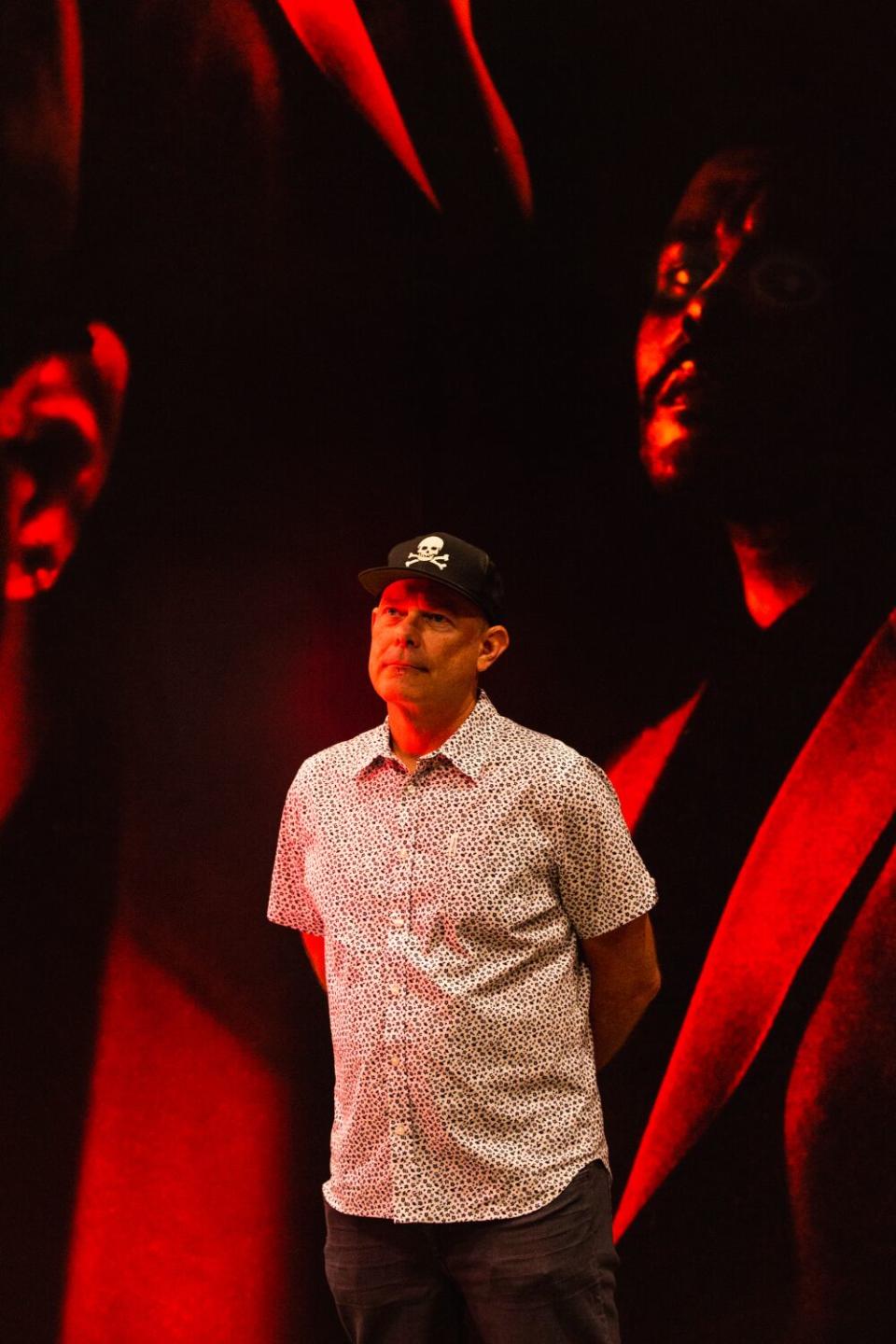
In terms of big picture themes, the Weeknd maze doesn't necessarily go term-paper deep. "We wanted to take the idea of L.A. as an image-obsessed culture and take it to the ultimate level," Murdy says.
That allowed for some grotesque scenes, such as a bathroom that doubles as a makeshift plastic surgery room, complete with a large contraption — one that looks more like a metallic tool set than anything found in a hospital — serving as a liposuction machine. Even in the midafternoon light, it's stomach-churning. "The figure is a fiberglass figure with silicone skin over it," Murdy says. "But then we cut out holes in the fiberglass," which allows guests to see fat bubbling and being sucked out of the body. Expect again to be splashed before leaving the room.
Murdy says Halloween Horror Nights is simply trying to reflect what people are scared of today, be it the fears and insecurities of an appearance-focused culture or larger topics affecting America.
"If you go back to the '50s, the movies we were making as a studio at the time were giant atomic mutated tarantulas," Murdy says. "Or at Warner Bros., 'Them!' Or in Tokyo, 'Godzilla.' Those are born out of our fear of nuclear annihilation. This year, very intentionally, we have an original house called Scarecrow. It's our ecological horror story. It's set in the Dust Bowl of the 1930s, but it's about climate change."
And if the messages go over guests' heads, the screams when they're splashed with what appears to be human body fat will indicate the houses were a success.
"When I was showing that to my team," Murdy says, "they were like, 'That's so wrong.' I said, 'I know. But it's so right for this.'"
This story originally appeared in Los Angeles Times.

